Another Owl Tour today, and the weather forecast was a little better than last time out – a cold NW wind and the chance of some wintry showers forecast, but it dawned bright, clear and cold. If it stayed like that, we should be in with some luck.
We started with a drive round some favoured fields to see if the local Barn Owls were still out hunting. However, it had been clear since dawn and it looked like they had gone back to bed already. So we decided to try for Little Owls instead, and see what else we could pick up on the way.
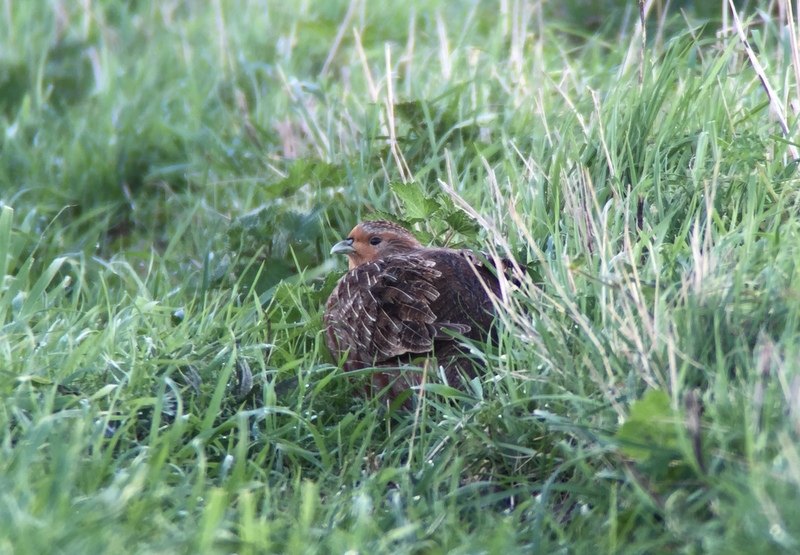 Grey Partridge – 3 were feeding on the edge of the field
Grey Partridge – 3 were feeding on the edge of the field
While the sun was out, there was a cold wind and at our first stop there was no sign of the Little Owl in its usual sunbathing spot when we arrived. We contented ourselves instead with admiring the farmland wildlife. A covey of Red-legged Partridges were grubbing around on the edge of the track on one side of the road and three Grey Partridges were tucked down in the verge on the edge of the field the other side. It was nice to be able to compare the two.
Out in the field beyond, several earth-covered lumps revealed themselves on closer inspection to be Brown Hares. They were huddled down in the winter wheat, perhaps a bit cold for them to be boxing yet. A small flock of Golden Plover flew over in tight formation. A Kestrel was hovering over a patch of rough grass further along the road.
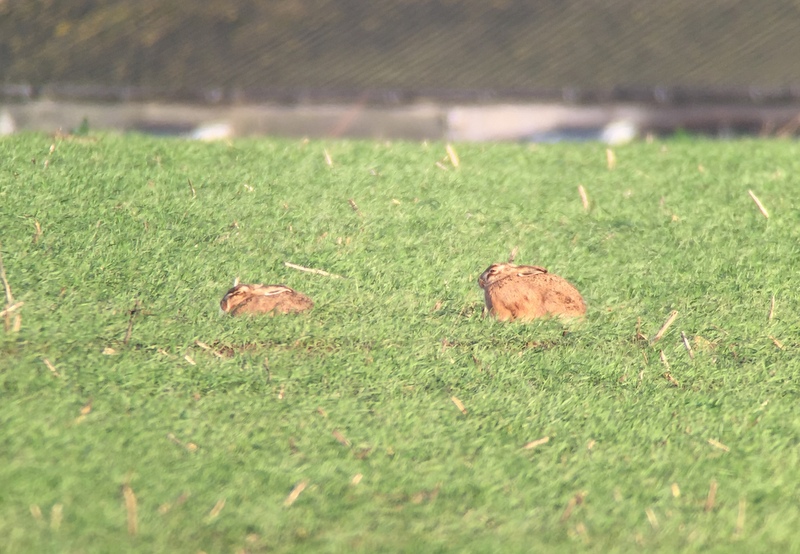 Brown Hares – we saw lots in the fields today
Brown Hares – we saw lots in the fields today
We turned back to the farm buildings and another scan finally revealed a small fluffy ball, a Little Owl, not in its usual spot but tucked down on the edge of a broken window. It was catching the sun, but presumably more sheltered from the wind here. We got it in the scope and had a good look at it, before it disappeared inside the building. We turned to scan the fields again and picked up another Little Owl on the farm buildings on the other side of the road. It was a bit more distant, but enjoying the winter sunshine in the lee of the wind. That was a great start – two Little Owls.
We worked our way on west, checking out some more Little Owl sites as we went, but none of the others were out today. A Red Kite flew lazily over the road. We decided to head over to Titchwell for some general birding through the middle of the day, and return to the owls in the afternoon. We drove round via Choseley, but there was no sign of the Rough-legged Buzzard when we stopped briefly – just several Common Buzzards and a Marsh Harrier over the fields. The hedgerow by the barns was alive with Yellowhammers.
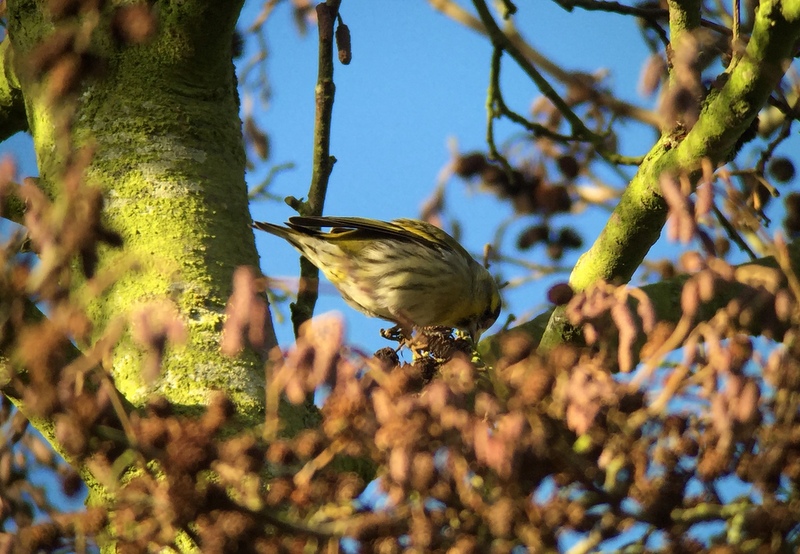 Siskin – several were in the trees by the picnic area
Siskin – several were in the trees by the picnic area
The car park at Titchwell was very busy today, so we made our way straight towards the Visitor Centre. We could hear lots of finches in the trees around the picnic area, so we stopped for a closer look. In amongst the Goldfinches feeding in the alders were several Siskins. When they caught the sunlight, they shone golden yellow and green. The feeders around the Visitor Centre were also full of finches, but the standout bird here was the single Marsh Tit which kept darting in, quickly snatching a sunflower seed, and disappearing back into the bushes to deal with it.
A careful scan of the ditches alongside the main path revealed the Water Rail again, in its usual place hidden beneath the overgrown vegetation. We watched it poking around on the edge of the water – its long red bill and camouflaged black-streaked brown upperparts. When it made a bolt further along the ditch, it came out in the open for a while so we could get a better look at it. It was always nervous and didn’t stay out in the open for long.
 Water Rail – in the ditch along the main path
Water Rail – in the ditch along the main path
There were lots of Rock Pipits on the drained grazing meadow pool today, at least a dozen. At first we couldn’t find the Water Pipit, but then it appeared from behind the reeds right down at the front. It was great to see both species alongside each other – the much whiter underparts of the Water Pipit really standing out compared to the much dirtier and more heavily streaked Rock Pipits. A Marsh Harrier was hanging in the air over the reeds behind.
After the stormy weather in the week, and despite the colder weather, the number of ducks on the freshmarsh was well down on recent visits. Still, there was a good selection to admire – Wigeon, Teal, Shoveler and Gadwall. Several groups of chattering Brent Geese dropped in from the saltmarsh for a bathe before flying back out to resume feeding.
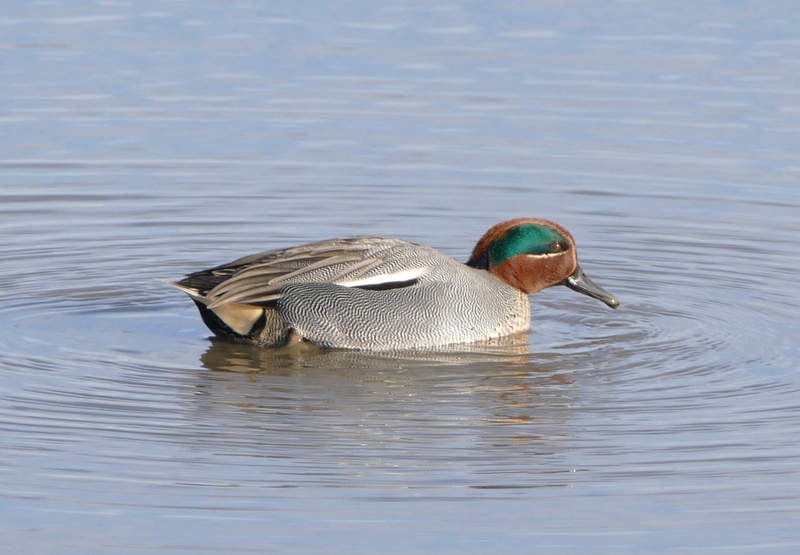 Teal – the drakes are looking particularly smart currently
Teal – the drakes are looking particularly smart currently
The huddle of around 30 Avocets was still clustered on the edge of one of the islands, a good number here for this time of winter. A group of Black-tailed Godwits was roosting with them. There is more mud on the freshmarsh now, as the water level has started to recede, and several Dunlin were scurrying around making the most of it. A single Knot was in with them, giving a great side-by-side comparison.
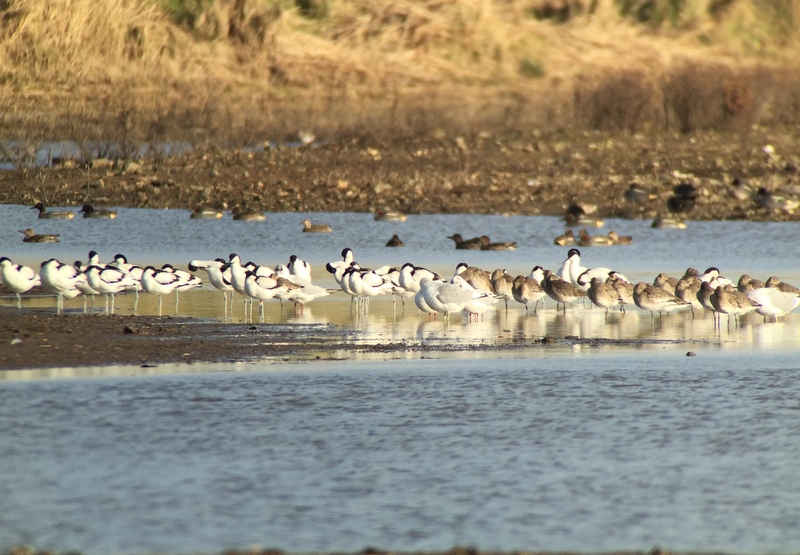 Avocets & Black-tailed Godwits – roosting on the freshmarsh
Avocets & Black-tailed Godwits – roosting on the freshmarsh
There were lots of gulls loafing around on the water out here today – when we got out to the beach later, we would see why. They were mainly Herring Gulls, Common Gulls and Black-headed Gulls. A careful scan through produced a single winter-plumaged adult Mediterranean Gull. It was bathing, splashing around in the water and flapping its wings, flashing its plain white wing tips. Then it flew over to one of the islands to preen. We noted its bright red bill, heavier than a Black-headed Gull‘s, and its black bandit mask (rather than the black hood of summer plumage).
 Mediterranean Gull – this adult was bathing on the freshmarsh
Mediterranean Gull – this adult was bathing on the freshmarsh
With all the bright weather, we decided to make the most of it and head straight out towards the beach. The tide was just going out and there was a great selection of waders on the Volunteer Marsh. From the corner by the path to the Parrinder Hide, we stopped to admire them. There were several more Knot on here, feeding on the mud, and lots of Redshanks as usual. A Grey Plover was wrestling with a worm, attempting to prise it out of the mud. When it finally pulled it out, the Curlew which had been eyeing it jealously made a bid to snatch it.
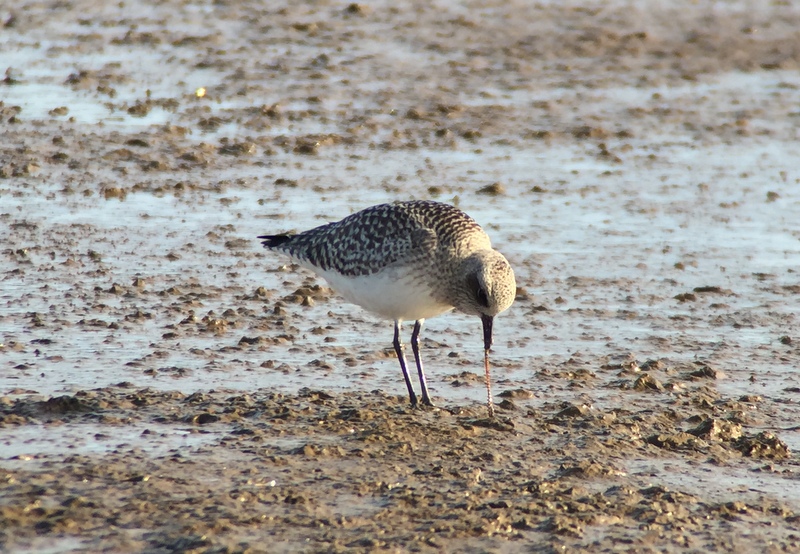 Grey Plover – trying to pull a worm out of the mud
Grey Plover – trying to pull a worm out of the mud
A Ringed Plover flew in and joined them. We watched it feeding – with a very similar action to the Grey Plover, walking a few steps and stopping to scan the mud, bending down to pick things from the surface. The Ringed Plover managed to pull out a particularly large worm and hurried down to one of the small creeks to wash it before gulping it down before it could be stolen.
At the other end of the Volunteer Marsh, a Bar-tailed Godwit flew in and landed on the mud close to the path. This bird has an injured foot and seems to have taken to feeding around here in recent weeks. It gave us a great opportunity to have a close look at it – noting some of the key differences from the Black-tailed Godwits we had seen earlier. When it flapped its wings, we even got a great view of its barred tail.
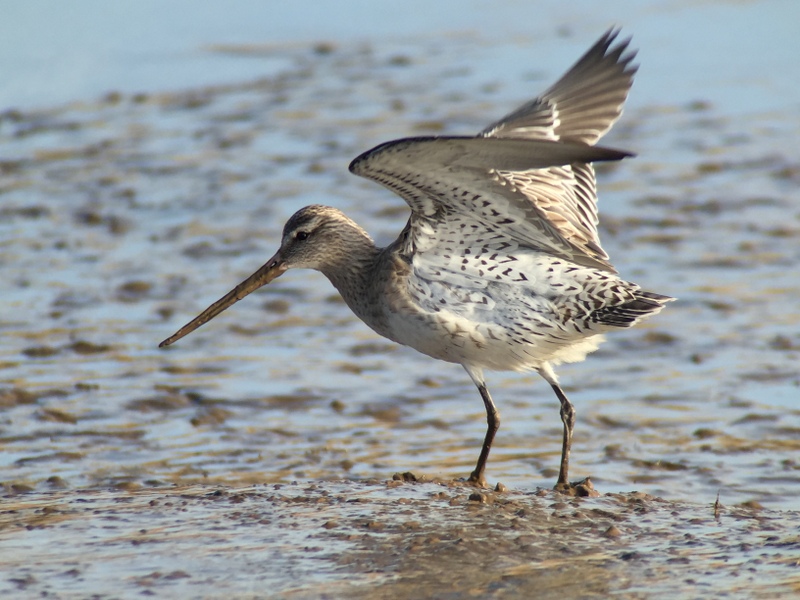 Bar-tailed Godwit – flashing its barred tail
Bar-tailed Godwit – flashing its barred tail
Out at the back of the Tidal Pools, a much paler wader stood out from the rather dark grey-brown Redshanks. We got it in the scope – a Spotted Redshank, in pale silvery grey and bright white winter plumage. We also noted its longer and finer bill compared to the Common Redshanks nearby. Several Little Grebes were out on the water, diving constantly, along with a female Goldeneye. We got the latter in the scope and admired its bright golden-yellow iris.
Out on the beach, the tide was still mostly in. Along the high tide line was a huge throng of gulls scattered along the beach all the way across towards Brancaster. The storm we had seen earlier in the week, with strong north winds and high tides, had thrown up loads of shellfish and other sealife onto the shore. The gulls had moved in to take advantage of it.
 Gulls – a huge throng was feeding on the beach
Gulls – a huge throng was feeding on the beach
We had a good look through the gulls, in case we could find something interesting among them. We did find several bright silvery grey Sanderling running in and out of the throng. Lots of Oystercatchers and Turnstones were also making the most of the bounty on the beach. There didn’t appear to be much on the sea today, which was still rather rough. A nice drake Red-breasted Merganser flew past. We had a busy afternoon planned and it was rather cold out on the beach, so we didn’t linger long and headed back to the Visitor Centre.
After lunch, we had a quick swing round via Choseley again. Although the Rough-legged Buzzard had just been reported dropping down behind a hedge, when we drove round to the other side to check it out all we could find were a couple of Common Buzzards, including one rather pale one. We also stopped briefly at Brancaster Staithe, but there was no sign of the Red-necked Grebe here today. We did admire the little group of Red-breasted Mergansers diving in the harbour and the nice selection of waders on the mud.
We had seen barely a hint of the forecast wintry showers and it was a lovely bright and sunny afternoon – perfect for owls. We made our way back along the coast road, scanning the favoured for any sign of a ghostly white shape. It didn’t take long to find our first Barn Owl, perched in a tree by a horse paddock near the road. It was hard to find somewhere to stop, but it took off and we watched it for a while as it circled over the grass before disappearing over the hedge at the back. A little further along, we found another more distant Barn Owl, out hunting over the freshmarsh at Holkham.
Owl time was upon us already, but we managed a quick stop at Wells. Out on the boating lake, beyond all the resident Mallards, we quickly picked out the two Scaup. Both appeared to be first winter drakes, with mostly grey backs still marked with brown along the top of the white flanks. They were asleep at first, but one woke up and started diving. We could see its green-tinted head and yellow iris.
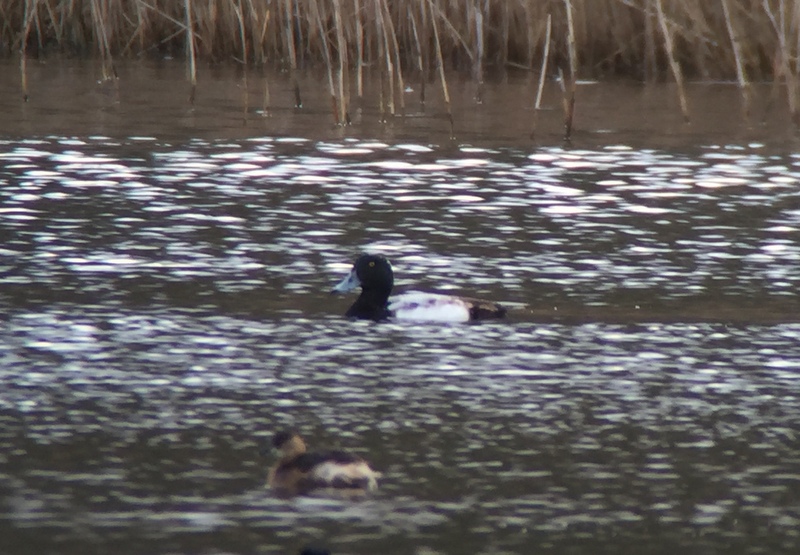 Scaup – one of two at Wells today
Scaup – one of two at Wells today
Then it was back to Blakeney for a walk out on the seawall. It seemed rather quiet at first and we remembered how cold it was out in the wind with no shelter. Then a Barn Owl appeared quartering the marshes in front of us. We had hoped to get a good look at it through the scope, but it kept disappearing behind the reeds. When it did land on a post briefly, it was half hidden and as we tried to reposition ourselves it was off again. It then worked its way further over.
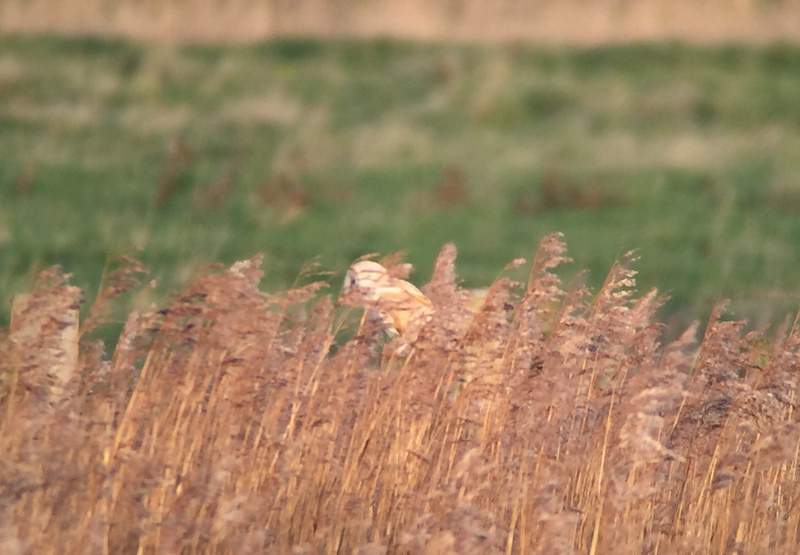 Barn Owl – kept frustratingly hidden when it landed
Barn Owl – kept frustratingly hidden when it landed
Another two Barn Owls appeared, but further over towards the back of the Freshes. The first Barn Owl then worked its way out into the middle. There was no sign of the hoped for Short-eared Owl this afternoon, so we decided to head inland to see if we could find a more amenable Barn Owl in a more sheltered spot. We hadn’t gone far when we found one unexpectedly on the gatepost of a house, right by the road. Unfortunately, it saw us coming and was off through the trees.
We drove round to another suitable spot and got out for a walk round. A couple of skeins of Pink-footed Geese came low overhead calling loudly, a lovely sight and sound in the evening light. Scanning the edge of the marshes, we found the Barn Owl and this one was perched on a post for us. It took off but landed on another post nearby and started to scan the grass below. This time we got it in the scope and had a really good look at it, our seventh Barn Owl of the afternoon and the best performer!
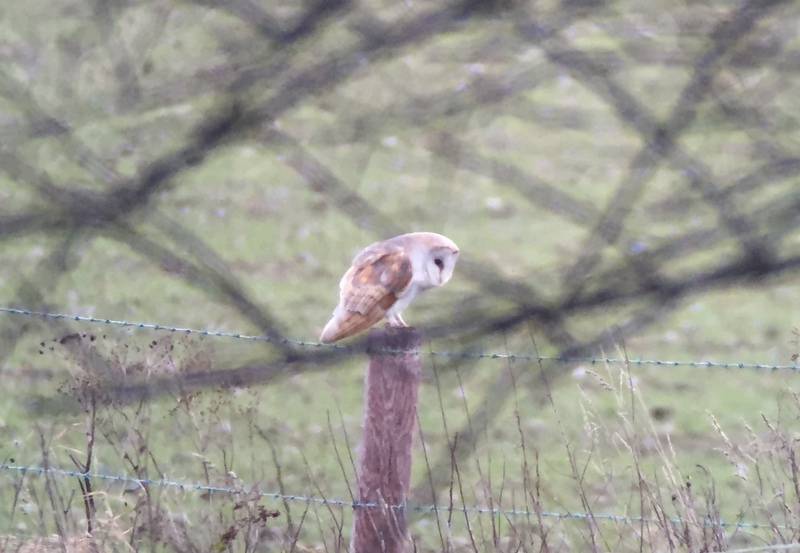
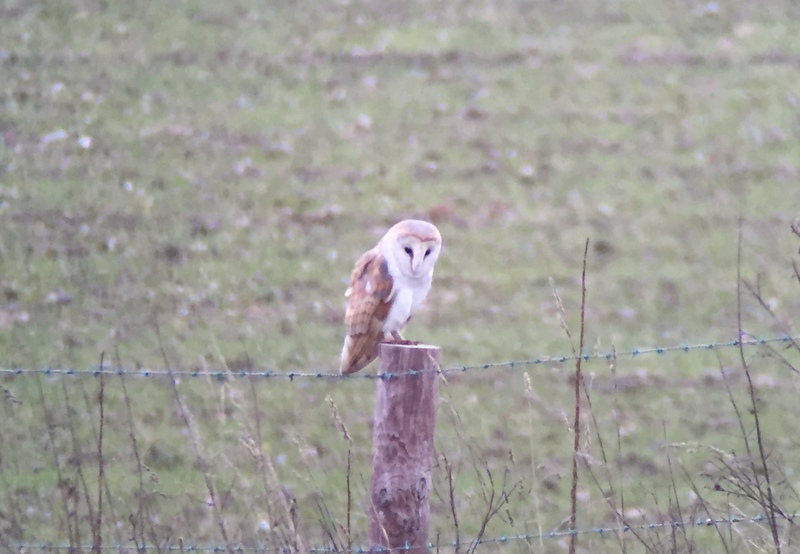 Barn Owl – our seventh of the afternoon
Barn Owl – our seventh of the afternoon
The afternoon was getting on, and we needed to be in position for the Tawny Owls, so we drove on and walked out to the edge of some woodland. It wasn’t long before the first one began hooting, some distance off in the trees. Then a second started up. Suddenly a large dark shape appeared through the trees, a Tawny Owl coming out of its roost site, flying silently on its broad rounded wings. Even better, it landed up in a tree in front of us. We got it in the scope – great views – looking straight at us.
It remained there, perched for a minute or so in the last light of the afternoon, before dropping away silently through the trees beyond. What a way to end the day!
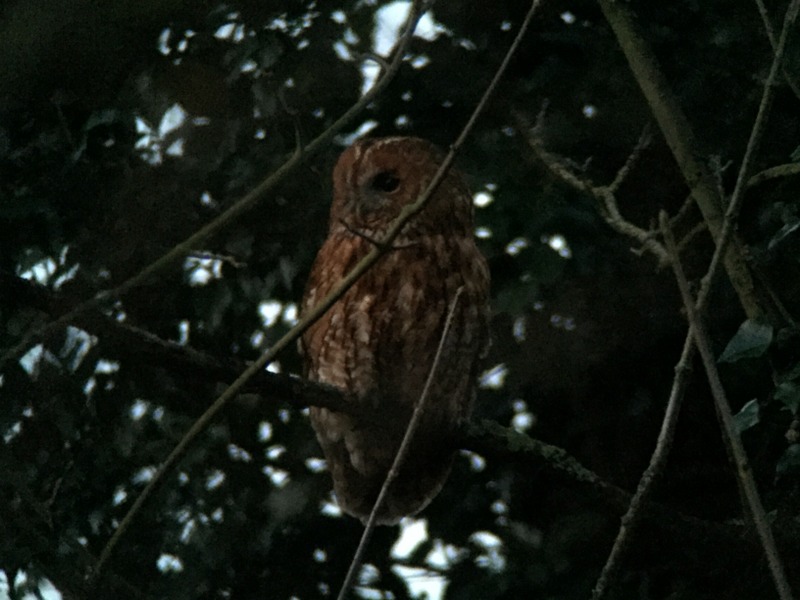 Tawny Owl – in the trees at dusk (this taken the previous evening)
Tawny Owl – in the trees at dusk (this taken the previous evening)
















